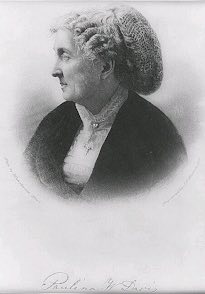The work of Paulina Kellogg Wright Davis as a women’s rights advocate, social reformer, educator, and author extended over forty years from the late 1830s to her death in 1876. Davis began her work for women’s rights, abolition, and temperance causes when she was only twenty and newly married to Francis Wright, a wealthy merchant from Utica, NY.
In the late 1830s, she met Elizabeth Cady Stanton and Ernestine Rose, with whom she joined in a petition to the New York legislature that eventually led to the passage of the Married Women’s Property Act in 1848 that gave married women control of their own personal property and real estate.
Following the death of Francis Wright in 1845, Davis was left an independent and wealthy woman. She invested her time in studying the anatomy and physiology of women and then conducted a lecture series on female physiology and anatomy, unprecedented in her time, which is said to have encouraged some of her listeners to join the first generation of women physicians.
In 1849 she married Thomas Davis, a Rhode Island Congressman and went with him to Washington. In 1850, she was an organizer and then served as president of the First National Women’s Rights Convention in Worcester, MA, which drew participants from nine states. She repeated this the next year at the Second National Women’s Rights Convention, again in Worcester.
From 1853 to 1855, she edited and published a distinctively women’s rights newspaper The Una, which expressed broad views of individual freedom. Post-Civil War, she helped found the New England Woman Suffrage Association. In 1871, she published A History of the National Woman’s Rights Movement.
When a split occurred in the women’s rights movement, she supported the National Woman Suffrage Association with Susan B. Anthony and Elizabeth Cady Stanton. At her funeral, Stanton and Anthony eulogized Davis and urged others to follow her lifelong example of service to women.

